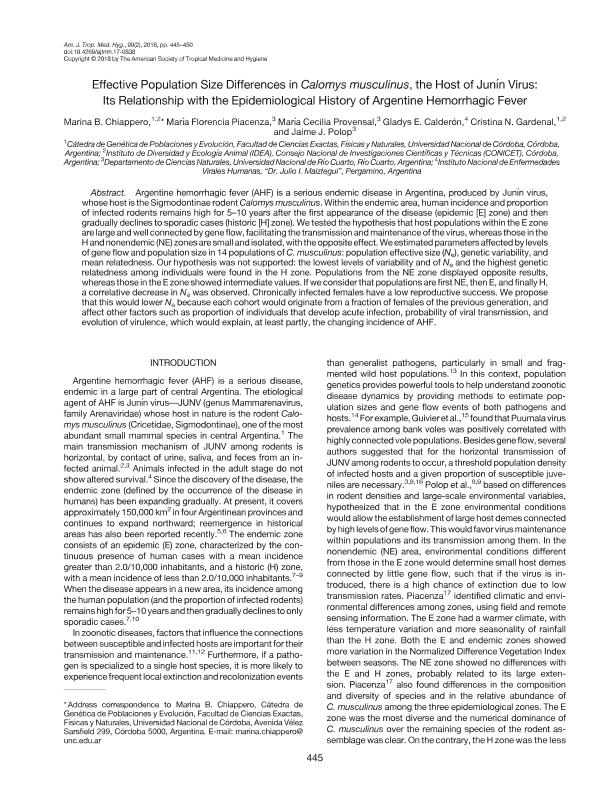Artículo
Effective population size differences in calomys musculinus, the host of Junín Virus: Their relationship with the epidemiological history of argentine hemorrhagic fever
Chiappero, Marina Beatriz ; Piacenza, Maria Florencia
; Piacenza, Maria Florencia ; Provensal, María Cecilia; Calderón, Gladys Ethel; Gardenal, Cristina Noemi
; Provensal, María Cecilia; Calderón, Gladys Ethel; Gardenal, Cristina Noemi ; Polop, Jaime Jose
; Polop, Jaime Jose
 ; Piacenza, Maria Florencia
; Piacenza, Maria Florencia ; Provensal, María Cecilia; Calderón, Gladys Ethel; Gardenal, Cristina Noemi
; Provensal, María Cecilia; Calderón, Gladys Ethel; Gardenal, Cristina Noemi ; Polop, Jaime Jose
; Polop, Jaime Jose
Fecha de publicación:
10/2018
Editorial:
American Society of Tropical Medicine and Hygiene
Revista:
American Journal of Tropical Medicine and Hygiene
ISSN:
0002-9637
e-ISSN:
1476-1645
Idioma:
Inglés
Tipo de recurso:
Artículo publicado
Clasificación temática:
Resumen
Argentine hemorrhagic fever (AHF) is a serious endemic disease in Argentina, produced by Junín virus, whose host is the Sigmodontinae rodent Calomys musculinus. Within the endemic area, human incidence and proportion of infected rodents remains high for 5-10 years after the first appearance of the disease (epidemic [E] zone) and then gradually declines to sporadic cases (historic [H] zone). We tested the hypothesis that host populations within the E zone are large and well connected by gene flow, facilitating the transmission and maintenance of the virus, whereas those in the H and nonendemic (NE) zones are small and isolated, with the opposite effect. We estimated parameters affected by levels of gene flow and population size in 14 populations of C. musculinus: population effective size (Ne), genetic variability, and mean relatedness. Our hypothesis was not supported: the lowest levels of variability and of Ne and the highest genetic relatedness among individuals were found in the H zone. Populations from the NE zone displayed opposite results, whereas those in the E zone showed intermediate values. If we consider that populations are first NE, then E, and finally H, a correlative decrease in Ne was observed. Chronically infected females have a low reproductive success. We propose that this would lower Ne because each cohort would originate from a fraction of females of the previous generation, and affect other factors such as proportion of individuals that develop acute infection, probability of viral transmission, and evolution of virulence, which would explain, at least partly, the changing incidence of AHF.
Archivos asociados
Licencia
Identificadores
Colecciones
Articulos(IDEA)
Articulos de INSTITUTO DE DIVERSIDAD Y ECOLOGIA ANIMAL
Articulos de INSTITUTO DE DIVERSIDAD Y ECOLOGIA ANIMAL
Citación
Chiappero, Marina Beatriz; Piacenza, Maria Florencia; Provensal, María Cecilia; Calderón, Gladys Ethel; Gardenal, Cristina Noemi; et al.; Effective population size differences in calomys musculinus, the host of Junín Virus: Their relationship with the epidemiological history of argentine hemorrhagic fever; American Society of Tropical Medicine and Hygiene; American Journal of Tropical Medicine and Hygiene; 99; 2; 10-2018; 445-450
Compartir
Altmétricas



